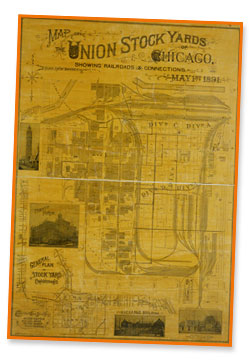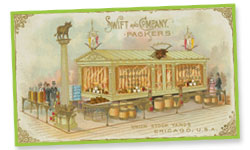Hot Dog!
Elementary: Grades 3–4
Story
Page: 1 | 2 | 3 | 4 | 5 | 6 | 7 | 8 | 9
Uncle John went into his desk drawer and shuffled through papers until he found what he was looking for. "This is a map of the stockyards from when I was a boy. It shows how all the railroads connected. Look at how big the Union Stock Yard was."
Allan and Ruth agreed. It was huge. "Did you work on those stockyard trains?" Ruth asked.
"Oh, no, I was a Pullman porter. I worked on trains that carried people. But I always thought those stockyard railroads were something else so I learned what I could."
"But how did the meats go on the trains far away without going bad?" Allan asked.
"That's the other amazing thing," Uncle John answered, his eyes twinkling. "Let me find something else." He searched some more in the desk and returned with a small card. "Look at this," he said.
Allan read the writing: "'Swift and Company Packers, Union Stock Yards, Chicago, USA.' It's a train car with meat in it!" Allan exclaimed. "It says Swift Refrigerator Line, Fresh Meat Express. So the train car was like a big refrigerator?"
"Yes," Uncle John explained. "Gustavus Swift was a pioneer in the meat industry. He invented train cars with boxes of ice that chilled the air, letting Chicago's meats, like hot dogs, to go all over the country without going bad."
"Is the stockyard still there?" Ruth asked.
Allan nodded. "We've smelled the stockyard, Ruthie. You know that bad smell on hot days? That's the stockyard."
"Allan's right. It's not as big as before, but it's still there. Now that people usually use trucks for shipping instead of trains, it's not the same," Uncle John grumbled. "But meatpacking is still important here. In fact, there's someone you should meet. Come on."
While Uncle John got himself ready, Allan took out his notebook and wrote, "Reason number two: Chicago's railroads and stockyards."
Downloads (pdf)


